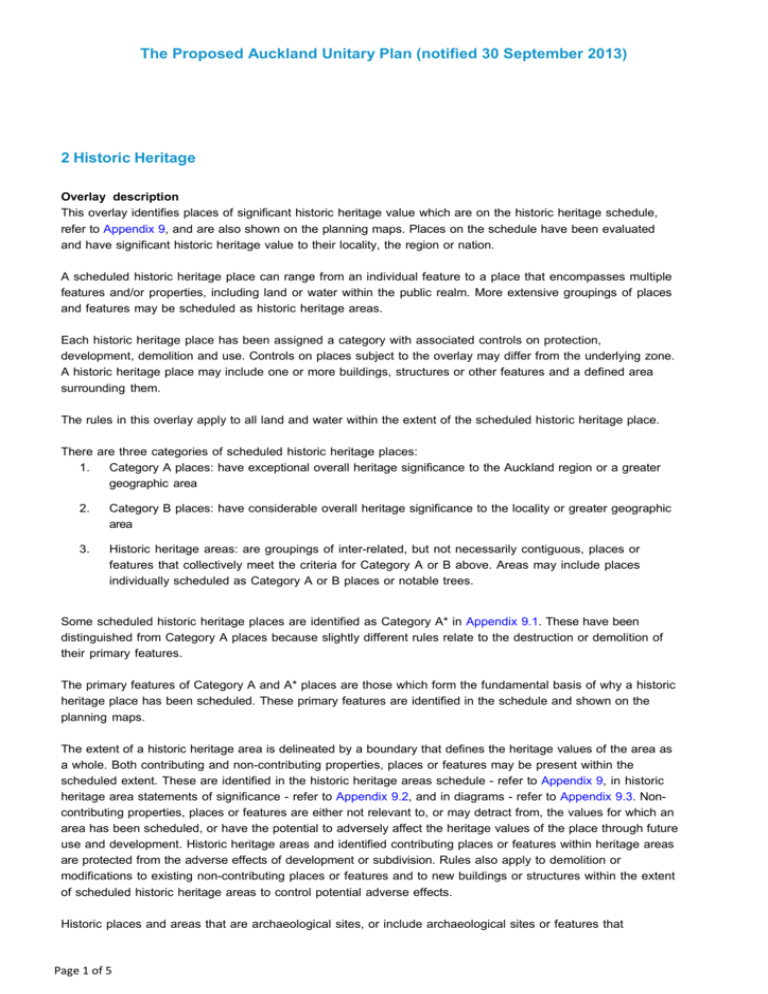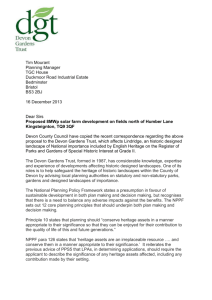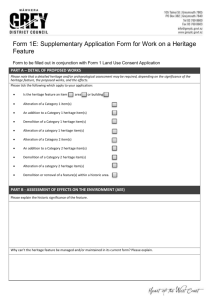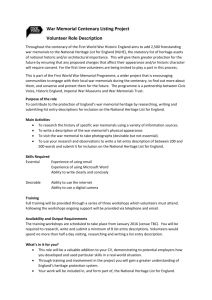The Proposed Auckland Unitary Plan
advertisement

The Proposed Auckland Unitary Plan (notified 30 September 2013) 2 Historic Heritage Overlay description This overlay identifies places of significant historic heritage value which are on the historic heritage schedule, refer to Appendix 9, and are also shown on the planning maps. Places on the schedule have been evaluated and have significant historic heritage value to their locality, the region or nation. A scheduled historic heritage place can range from an individual feature to a place that encompasses multiple features and/or properties, including land or water within the public realm. More extensive groupings of places and features may be scheduled as historic heritage areas. Each historic heritage place has been assigned a category with associated controls on protection, development, demolition and use. Controls on places subject to the overlay may differ from the underlying zone. A historic heritage place may include one or more buildings, structures or other features and a defined area surrounding them. The rules in this overlay apply to all land and water within the extent of the scheduled historic heritage place. There are three categories of scheduled historic heritage places: 1. Category A places: have exceptional overall heritage significance to the Auckland region or a greater geographic area 2. Category B places: have considerable overall heritage significance to the locality or greater geographic area 3. Historic heritage areas: are groupings of inter-related, but not necessarily contiguous, places or features that collectively meet the criteria for Category A or B above. Areas may include places individually scheduled as Category A or B places or notable trees. Some scheduled historic heritage places are identified as Category A* in Appendix 9.1. These have been distinguished from Category A places because slightly different rules relate to the destruction or demolition of their primary features. The primary features of Category A and A* places are those which form the fundamental basis of why a historic heritage place has been scheduled. These primary features are identified in the schedule and shown on the planning maps. The extent of a historic heritage area is delineated by a boundary that defines the heritage values of the area as a whole. Both contributing and non-contributing properties, places or features may be present within the scheduled extent. These are identified in the historic heritage areas schedule - refer to Appendix 9, in historic heritage area statements of significance - refer to Appendix 9.2, and in diagrams - refer to Appendix 9.3. Noncontributing properties, places or features are either not relevant to, or may detract from, the values for which an area has been scheduled, or have the potential to adversely affect the heritage values of the place through future use and development. Historic heritage areas and identified contributing places or features within heritage areas are protected from the adverse effects of development or subdivision. Rules also apply to demolition or modifications to existing non-contributing places or features and to new buildings or structures within the extent of scheduled historic heritage areas to control potential adverse effects. Historic places and areas that are archaeological sites, or include archaeological sites or features that Page 1 of 5 The Proposed Auckland Unitary Plan (notified 30 September 2013) contribute to the significance of the scheduled place, are identified in the heritage schedule. These are subject to additional controls on land disturbance and other activities that have the potential to adversely affect archaeological sites. In addition to the requirements of the Unitary Plan, the Historic Places Act 1993 requires an applicant to obtain an authority from the New Zealand Historic Places Trust to destroy, damage or modify any archaeological site meeting the criteria set out in that act, whether or not it is recorded or scheduled. The rules relating to land use in the underlying zone will apply to scheduled historic heritage places. Where there is a conflict between the rules in the underlying zone and the rules for the Historic Heritage Place overlay, the latter takes precedence. Where an application is sought to use a scheduled historic heritage place for an activity that is not provided for as a permitted activity in the underlying zone or provided for in Tables 1 - 3, refer to clause 2.1 of the Historic Heritage overlay rules, this will be assessed as a discretionary activity. In considering the application, the council will have regard to the extent to which the proposed use will secure the scheduled historic heritage places long-term viability, impact on the adjoining neighbourhood and retention of heritage values. The rules for scheduled historic heritage places recognise the importance of ongoing repair and maintenance of historic heritage places and allows these as a permitted activity, subject to complying with permitted activity standards. For the purpose of this overlay the following terms are explained: • Conservation Means all of the processes of understanding and caring for a place so as to safeguard its cultural heritage value. • Demolition or destruction Means any activity that destroys, damages or modifies in whole or in part, the fabric of a historic heritage place and adversely affects the values that contribute to the significance of the place. • Setting Means elements of the surrounding or spatial context within which a historic heritage place is experienced, including sea, sky, land, structures, features, backdrop, skyline and views to and from the place. Setting can include landscapes, townscapes, and streetscapes and relationships with other historic heritage places which contribute to the value of the place. • Place Means the same as ‘place’ in the ICOMOS New Zealand Charter for the Conservation of Places of Cultural Heritage Value (revised 2010).That is: 'Place means any land having cultural heritage value in New Zealand, including areas; cultural landscapes; buildings, structures, and monuments; groups of buildings, structures, or monuments; gardens and plantings; archaeological sites and features; traditional sites; sacred places; townscapes and streetscapes; and settlements. Place may also include land covered by water, and any body of water. Place includes the setting of any such place'. • Maintenance Means the same as ‘maintenance’ in the ICOMOS NZ Charter for the Conservation of Places of Cultural Heritage Value (revised 2010).That is: 'Regular and on-going protective care of a historic heritage place to prevent deterioration and to retain its historic heritage value'. Maintenance is to be distinguished from repair. • Reconstruction Means the same as ‘reconstruction’ in the ICOMOS NZ Charter for the Conservation of Places of Cultural Page 2 of 5 The Proposed Auckland Unitary Plan (notified 30 September 2013) Heritage Value (revised 2010).That is: 'Reconstruction means to build again as closely as possible to a documented earlier form, using new materials'. • Dismantle Relates to a feature within a scheduled historic heritage place and means to temporarily disassemble or take apart components or fabric of a building or structure for the purposes of later restoration in its existing location. • Fabric Means all the physical material of a historic heritage place, including sub-surface material, structures, and interior and exterior surfaces, patina of age; fixtures and fittings; and gardens and plantings. • Features A physical entity within a scheduled historic heritage place that is discernible as an individual element within the place. A feature can be an archaeological feature, such as pits, terraces or a midden; a building, object or structure. • Restoration To return the existing fabric of a historic heritage place to a known earlier state by reassembling and reinstating existing components in accordance with known earlier details without introducing new material, and/or removing additions or accretions that detract from its historic heritage value. Objectives 1. A scheduled historic heritage place is protected and conserved while enabling appropriate, use, maintenance and repair. 2. A scheduled historic heritage place is protected from inappropriate demolition or destruction and the adverse affects of development and/or subdivision. Policies Use, maintenance and repair of scheduled historic heritage places 1. Allow for the use of a scheduled historic heritage place where the proposed use: a. will not detract from the significance of the place b. will contribute to the ongoing maintenance and enhancement of the historic heritage values of the place c. is in accordance with good practice conservation principles and methods d. will not result in immediate or cumulative damage of the place e. will secure the long-term viability and retention of the place and not lead to adverse effects on the surrounding area. 2. Allow use of a scheduled historic heritage place, broader than those provided for in the zone or overlay, where it does not detract from the heritage values of the place and supports its protection and conservation. 3. Encourage and allow maintenance and repair appropriate to the scheduled historic heritage place where it is: a. based upon a clear understanding of the heritage values of the place b. 4. undertaken in accordance with good practice conservation principles and methods. Support use, maintenance and repair appropriate to scheduled historic heritage places through such measures as: Page 3 of 5 The Proposed Auckland Unitary Plan (notified 30 September 2013) a. reducing or waiving of consent application costs b. consider granting consent to infringing development controls for underlying zones provided this does not result in significant adverse environmental effects c. the availability of funding, grants d. provision of expert advice to land owners. Development and modification to scheduled historic heritage places 5. Require the assessment of the effects for proposed works to a scheduled historic heritage place to address all impacts the works may have on heritage values, the significance of the place, and its setting. 6. Require modifications to a scheduled historic heritage place to maintain or enhance the heritage values of the place, by: a. recovering or revealing heritage values b. removing features or additions that compromise the heritage values of the place c. minimising the loss of fabric that contributes to the heritage values and level of significance of the place d. not compromising the ability to interpret the place and the relationship to other heritage places e. complementing the form and fabric which contributes to, or is associated with, the heritage values f. g. 7. 8. retaining and integrating heritage values avoiding significant adverse effects on the place, such as loss, destruction or subdivision that would reduce or destroy its heritage values. Require development proposals that affect one or more places with identified historic, cultural or natural values to consider: a. the effects on all values b. the relationship between the places c. the effects on the landscape. Allow subdivision of a scheduled historic heritage place only if: a. it supports use and development that is complementary to the heritage values of the place b. all heritage values associated with the place have been considered and adverse effects are minimised. Demolition or destruction of scheduled historic heritage places 9. Prevent the destruction, partial, total or substantial demolition or destruction, or relocation beyond the site of the primary features of a Category A scheduled historic heritage place. 10. Avoid the destruction, partial, total or substantial demolition or destruction, or relocation, of Category A* primary features and Category B features, and other features located within a scheduled historic heritage place unless: a. the action is required to allow for significant public benefit that could not otherwise be achieved b. 11. the significant public benefit outweighs the retention of the feature, or parts of the feature. Provide for the temporary and reversible dismantling of parts of buildings or structures where this is necessary for the purposes of seismic strengthening, restoration or repair. Page 4 of 5 The Proposed Auckland Unitary Plan (notified 30 September 2013) 12. Support, in general, the partial, total or substantial demolition or destruction, or relocation of features, or parts of features, that detract from the heritage values of a scheduled historic heritage place or are identified as non-contributing within a scheduled historic heritage area. Historic heritage areas 13. Enable development and use of non-contributing places or features within an historic heritage area where these are compatible with the historic heritage values of the area. Page 5 of 5







